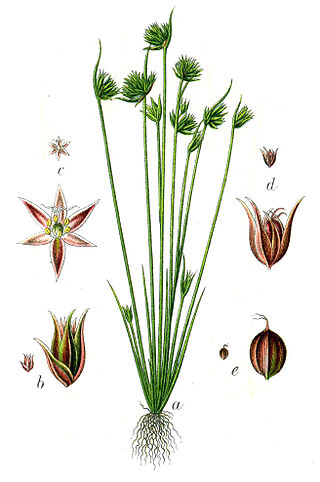
Linum bienne, the pale or narrowleaf flax, is a flowering plant in the genus Linum, native to the Mediterranean region and western Europe, north to England and Ireland.

Cirsium palustre, the marsh thistle or European swamp thistle, is a herbaceous biennial flowering plant in the family Asteraceae.

The sea beet, Beta vulgaris subsp. maritima(L.) Arcangeli., is an Old World perennial plant with edible leaves, leading to the common name wild spinach.

Silene flos-cuculi, commonly called ragged-robin, is a perennial herbaceous plant in the family Caryophyllaceae. It is native to Eurasia and has been introduced to North America.

Sporobolus maritimus, or synonymously as Spartina maritima, the small cordgrass, is a species of cordgrass native to the coasts of western and southern Europe and western Africa, from the Netherlands west across southern England to southern Ireland, and south along the Atlantic coast to Morocco and also on the Mediterranean Sea coasts. There is also a disjunct population on the Atlantic coasts of Namibia and South Africa.

Scheuchzeria palustris, is a flowering plant in the family Scheuchzeriaceae, in which there is only one species and Scheuchzeria is the only genus. In the APG II system it is placed in the order Alismatales of the monocots.

Aeonium arboreum, the tree aeonium, tree houseleek, or Irish rose, is a succulent, subtropical subshrub in the flowering plant family Crassulaceae.

Saxifraga paniculata is an alpine species of flowering plant in the saxifrage family, with native distribution in the temperate northern hemisphere. Common names include alpine saxifrage, encrusted saxifrage, lifelong saxifrage, lime-encrusted saxifrage, livelong saxifrage, white mountain saxifrage, and silver saxifrage.

Typha angustifolia is a perennial herbaceous plant in the genus Typha, native throughout most of Eurasia and locally in northwest Africa; it also occurs widely in North America, where its native status is disputed. It is an "obligate wetland" species that is found in fresh water or brackish locations. It is known in English as lesser bulrush, and in American as narrowleaf cattail.

Comarum palustre, known by the common name marsh cinquefoil, also purple marshlocks and swamp cinquefoil, is a waterside rhizomatous subshrub. It has a circumboreal distribution, occurring throughout cool temperate Asia, Europe, and North America, particularly in northern regions. It is most commonly found on lake shores, marshy riversides and stream margins, often partly submerged with foliage floating. It is a parent of some Fragaria–Comarum hybrids, ornamental plants produced by crossing with strawberries.

Verbascum blattaria, the moth mullein, is a flowering biennial plant belonging to the figwort family Scrophulariaceae. A native of Eurasia and North Africa, it has naturalized in the United States and most of Canada since its introduction and has become an invasive species there. It has been declared a noxious weed by the state of Colorado.

Centaurium erythraea is a species of flowering plant in the gentian family known by the common names common centaury and European centaury.

Juncus capitatus is a species of rush known by the common names dwarf rush and leafybract dwarf rush. It is native to Europe, Asia and North Africa. It is also an introduced species in parts of North America such as California and the Gulf Coast. It grows in moist areas, such as wet sand, vernal pools, and ditches.

Schenkia australis is a species of annual herb in the Gentianaceae family. It is endemic to Australia.

Zeltnera exaltata is a species of flowering plant in the gentian family known by the common names desert centaury and tall centaury. It is native to much of western North America from British Columbia to Arizona to Nebraska, where it grows in moist areas, generally with alkaline soils. This is an annual herb which is variable in appearance, especially in different habitat types. It grows up to about 35 centimeters in height, its slender stem with widely spaced pairs of oppositely arranged, pointed leaves 1 to 3 centimeters long. The inflorescence is an open array of flowers, each on a pedicel which may be several centimeters in length. The flower has generally four or five white or pink lobes, each somewhat rolled to appear narrow in shape.

Lobelia urens, commonly known as heath lobelia or acrid lobelia is a species of flowering plant in the bellflower family. It is predominantly native to western Europe but can also be found in northern Morocco and in the island of Madeira off Northwest Africa.

Potamogeton pusillus is a species of aquatic plant known by the common names small pondweed, lesser pondweed or least pondweed. It occurs in standing and slow-flowing freshwater habitats throughout the Northern Hemisphere.

Potentilla norvegica is a species of cinquefoil known by the common names rough cinquefoil, ternate-leaved cinquefoil, and Norwegian cinquefoil. It is native to Europe, Asia, and parts of North America, and it can be found elsewhere as an introduced species.

Veronica scutellata is a species of flowering plant in the plantain family known by the common names marsh speedwell, skullcap speedwell, and grassleaf speedwell. It is native to temperate Asia, Europe, northern Africa, and northern North America in a variety of wet habitats.

Primula pulverulenta, the mealy primrose or mealy cowslip, is a species of flowering plant in the family Primulaceae. It is native to damp habitats in China. It is a herbaceous perennial growing to 100 cm (39 in) tall by 60 cm (24 in) broad, with strong stems of deep pink flowers arising from basal rosettes of leaves in early summer. The flowers are grouped at intervals along the stem in a tiered formation, hence the common name "candelabra primula" which is often applied to this and other species with a similar arrangement.




















